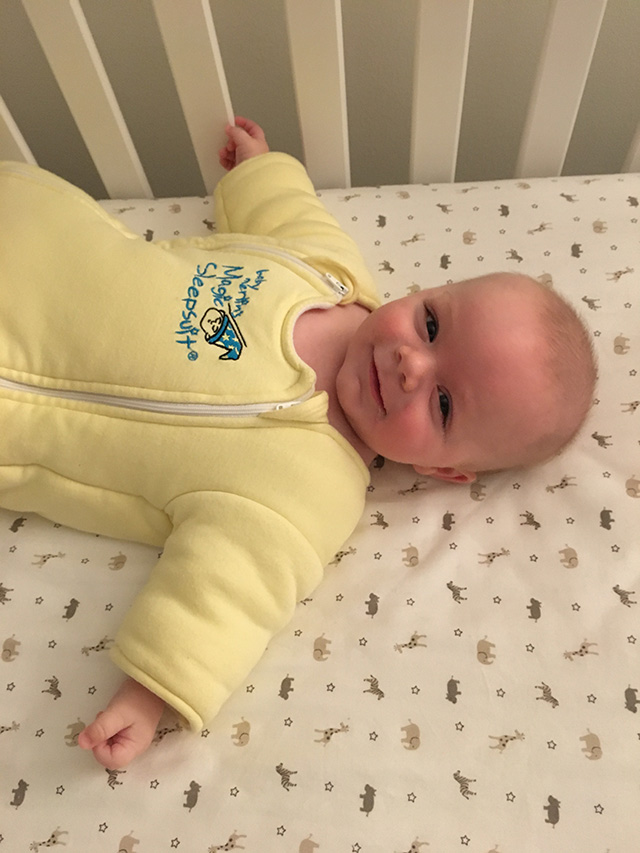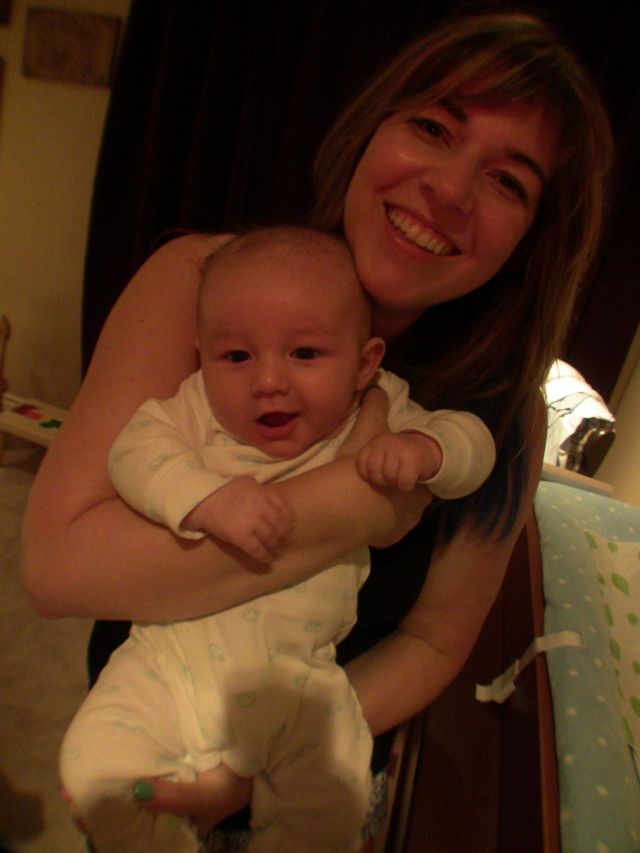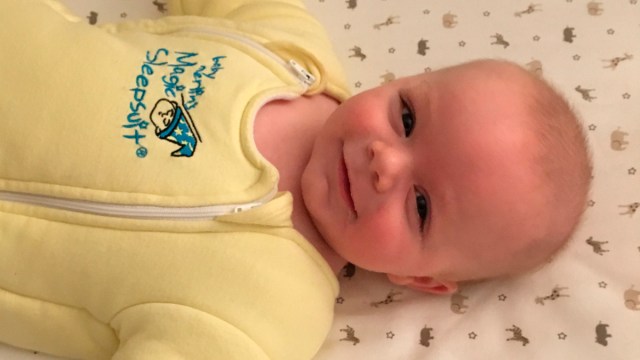It has “magic” right there in the name, but is this puffed-up jumpsuit actually the answer to all your infant-sleep woes?
My son was crying (again), which meant he wasn’t sleeping—which meant I wasn’t sleeping either. The clock read 3:58 a.m., and even though my brain despises middle-of-the-night math, I calculated that I’d put my 4-month-old back in his crib just 42 minutes ago. It was an all-night, every-night pattern: Sleep for 40-ish minutes and wail until mom comes to soothe you back to sleep. After three straight weeks of this and three months of non-sleeping colic before that, I wasn’t sure I could survive much longer.
After yet another sleepless night, I was at lunch with a mom friend explaining why the bags under my eyes were large enough to carry the groceries I’d just purchased, when she asked, “Have you tried Baby Merlin’s Magic Sleepsuit?” She went on to describe a puffy jumpsuit that she promised had helped her 4-month-old twins sleep through the night. This endorsement—and the lack of bags under her eyes—had me running to buy one of my own. Here’s what I learned about Baby Merlin’s Magic Sleepsuit.
What is Baby Merlin’s Magic Sleepsuit and how does it work?
Baby Merlin’s Magic Sleepsuit may sound like it was created by a medieval wizard but it’s actually the brainchild of Maureen Howard, a real-life sleep-deprived mom of four and pediatric physical therapist. She created the suit to help transition babies out of their swaddles. My son was a real swaddle guy, but once he rolled over at 3 months it was no longer a safe option, and he clearly wasn’t adjusting to sleep without it. With so many layers (super-soft cotton sandwiching a puffy layer of polyfil), the Baby Merlin sleepsuit gives 3 to 6-month-olds the secure feeling of a swaddle but with age-appropriate freedom of movement.
There are two zippers on either side of the front to easily get your babe in and out, and the arms and legs are uncinched for hands and feet to breathe, but just heavy enough to muffle your baby’s startle reflex (which was making his arms flail and waking him up). It’s important to note that though the puffy suit has a bit of weight, it’s not weighted, which is considered unsafe by the AAP.
Not only did the suit have more than 21-thousand positive reviews on Amazon, but it was also comforting to know that so many other moms were struggling with sleepless 3-month-olds—and with good reason. Kaley Medina, certified infant and child sleep specialist and founder of Live Love Sleep, says that around the third or fourth month, a significant shift occurs in your baby’s sleep patterns. While newborns only experience two stages of sleep, older babies adopt a “four-stage sleep cycle” with REM sleep decreasing from 50% to 25%. So, with your baby experiencing lighter sleep phases, they may wake up more often because they’re having trouble connecting through their sleep cycles. The swaddle-free bedtime transition, coupled with my little one’s change in sleep cycles, made our nights looooong. Could Merlin actually get my son to sleep?

What happened when I tried Merlin’s Magic Sleepsuit
My son’s new non-sleep pattern wasn’t going to disappear overnight, and I definitely wasn’t ready to start sleep training, so I ordered the Merlin suit. When it arrived, it was surprisingly soft on the inside and the outside. It was also super squishy and the thickness didn’t feel awkward or stiff. When I moved the front zippers, they slid easily, which seemed great for quick middle-of-the-night diaper changes. Then the real test: I put it on my son to get his opinion. While he did look like a hilarious mini version of the Stay Puft Marshmallow Man, he didn’t whine or struggle once zipped in. He seemed content, blowing bubbles and making his usual cooing sounds. But would he like it at night?
The first night my son slept in his Merlin Sleepsuit, I was nervous. I might have stayed up all night checking on him, but to my surprise, my son didn’t stay awake with me. He slept. After months of not even coming close to sleeping through the night, he only woke up once. I gently patted his chest to reassure him and he fell right back asleep. I felt a knot leave my stomach and breathed a sigh of relief. And this is how our lives went until he outgrew his suit. I was finally able to get some much-needed sleep knowing my son was dozing safely in his crib. Plus, the cost-benefit analysis was solid—at $39.95, the Baby Merlin Magic Sleepsuit costs the same as a week’s worth of Starbucks Grande Vanilla Lattes, and I would have given up anything to get some shuteye.
Related: Do I Have to Put My Baby on a Sleep Schedule?
Is Baby Merlin’s Magic Sleepsuit safe?
Before I put my son in the sleepsuit, I wanted to make damn sure it was safe. Howard has said the Magic Sleepsuit was designed and manufactured with safety as a top priority. As always, if you’re considering trying a new sleep aid, you should chat with your pediatrician first. The website encourages all parents who use the Merlin Magic Sleepsuit to stay up to date on APP guidelines and follow the standard ABCs of Sleeping: Alone, Back, and Crib. This means when using the Merlin Sleepsuit your baby needs to be sleeping on their back all alone in their crib (no stuffies, blankets, pillows, etc.).
Since this thing practically looks like a snowsuit one thing parents worry about is overheating. If anything, you’re supposed to dress your baby in a light layer, like a cotton onesie, while using the sleep suit. When I zipped my guy in, I dressed him in a light cotton t-shirt and a diaper. Some nights (depending on our room temperature), I left out the t-shirt, and this worked great for him. I had my baby’s room set to a comfortable temperature, a coolish 68 degrees Fahrenheit (the recommended range is 68 to 72), and checked on him regularly the first few nights just to make sure he didn’t feel hot.
When to use the sleepsuit
Sizing includes a small at 12-18 lb. and a medium at 18-21 lb. The recommended age for Merlin’s sleepsuit is 3 to 6 months when you’re transitioning your baby out of their swaddle. Once an infant starts rolling over, a tight swaddle (where their hands and arms aren’t free) is no longer safe for sleeping. Oh, and to make matters sleepier, this rolling-over developmental leap can coincide with an infant’s 3 to 4-month sleep regression. Hope Frazier, a pediatric sleep consultant and founder of In Heavenly Peace Sleep, says your baby’s change in sleep at this age isn’t regressing, but forward-moving. “Your infant is letting go of their newborn sleep and shifting forward into their adult sleeping patterns where they have lighter stages of sleep.” This can lead to waking up every few hours—exactly like my son was doing. Transitioning out of a swaddle and all the wake-ups were what led me to try the suit.

When to stop using your magic Merlin sleepsuit
The sleepsuit in all its plush glory is designed exclusively for back sleeping, so when your baby’s abs are strong enough to roll over while in the sleepsuit it’s time to say goodbye. Babies shouldn’t sleep in the suit in any other position than on their back. Also, if your baby seems to be “fighting” the suit, trying to roll in it, or acting fussy or squirmy at bedtime, it’s time to move on and give their bodies some more freedom.
How to transition baby out of their sleepsuit
There’s really not one magical way to transition your baby out of their baby Merlin sleepsuit. Some babies will have no issues moving on from the sleepsuit while for others it will play out like a sleep regression as they adjust to a less cozy life. At this point, you’ll transition your little one into a sleep sack and cross your fingers and toes that they sleep. This is why sleep consultants Frazier and Medina prefer jumping straight to sleep sacks after a baby is 3 months old because they’re officially capable of self-soothing. The sacks, which are designed as “wearable blankets,” cover your kid’s torso, legs, and feet but leave their arms out. Medina says she’s partial to the arms-free options because these designs grant babies the freedom to move their arms while they sleep, facilitating comfort and mobility. “It’s a win-win,” Medina begins, “peace of mind for parents knowing their little one is both snug and safe, and the baby enjoys uninterrupted rest with the freedom to wiggle around as they drift off to sleep.”
Both experts agree that sleep training can begin as early as 3 to 4 months, so if you’re comfortable and ready to train you can skip the sleepsuit (and the transition). Frazier says there are different levels to sleep training depending on your child and your own comfort. “The way your child falls asleep is what they’re going to look for in the middle of the night,” Frazier says. So, she would start by being consistent during your bedtime routine. Lie your baby down awake and then let them practice falling asleep unassisted. “You can give your baby a few minutes to fuss, and then go to them to give them a few gentle pats,” she says, which would be a gentle way to begin sleep training.
So, should you try Baby Merlin’s Magic Sleepsuit?
The biggest downside for us was the transition out of the suit. There was no easy way for my little guy to say goodbye. Looking back, I simply delayed our sleep training process by a few months. This is why Frazier generally dissuades her clients from using sleepsuits like the Baby Merlin. On the flip side, however, Frazier says it could be helpful for a child who is a very sensitive sleeper or has a strong Moro reflex. Medina explains that while these items may offer a sense of comfort, they aren’t essential for a baby to achieve a good night’s sleep. “There’s no need to invest in an additional transitional product like the Baby Merlin Sleepsuit, as babies will ultimately find comfort and safety in a standard sleep sack.”
That being said, one mom to another, my answer is yes. When friends complain that their 3-month-old isn’t sleeping, and I recognize the telltale ginormous bags under their eyes, I tell them my story. I suggest the magical sleepsuit and explain why it worked for us. My son needed some cushy support to quiet his moro reflex while his sleep pattern shifted. Baby Merlin’s Magic Sleepsuit safely achieved this for us. In fact, it’s become a family thing and my sister used it with her two babies. It was magic for her, too.
As a parent, it’s easy to look back and recall all the things you might do differently, but I know I’d choose Baby Merlin’s Magic Sleepsuit again. Not only did it help my son sleep, but I also know that in my heart I wasn’t ready to sleep train him at 3 months. The sleepsuit gave me the rest I needed and allowed me to see that my son was capable of sleeping through the night. That was huge, and it built up my confidence for the sleep-training journey that was to come.
Make sure to capture all the cute pics of your baby when they aren’t sleeping—and share them with your family and friends near and far—with the Tinybeans app. The secure platform puts parents in total control of who sees and interacts with photos and videos of their kids.











